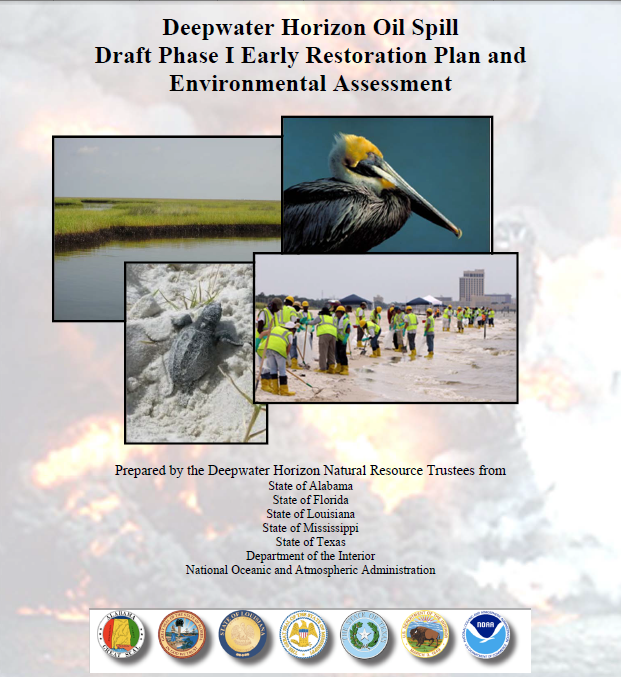Trustees Take First Step Towards Gulf Restoration in Release of Draft Early Restoration Plan
By Whit Remer, Environmental Defense Fund
 On Wednesday (Dec. 14), the Deepwater Horizon Natural Resource Damage Assessment (NRDA) Trustees released a draft restoration plan laying out the first phase of early projects funded under BP’s $1 billion dollar down payment to restore the Gulf. The draft plan (known as DERP/EA or “Draft Early Restoration Plan/Environmental Assessment) includes a total of eight projects that will be built across four states: Louisiana, Mississippi, Alabama and Florida. The public will have 60 days to review and comment on the DERP/EA, and a series of meetings for public input are scheduled in January and February.
On Wednesday (Dec. 14), the Deepwater Horizon Natural Resource Damage Assessment (NRDA) Trustees released a draft restoration plan laying out the first phase of early projects funded under BP’s $1 billion dollar down payment to restore the Gulf. The draft plan (known as DERP/EA or “Draft Early Restoration Plan/Environmental Assessment) includes a total of eight projects that will be built across four states: Louisiana, Mississippi, Alabama and Florida. The public will have 60 days to review and comment on the DERP/EA, and a series of meetings for public input are scheduled in January and February.
Louisiana has negotiated two projects that total just under $30 million of their initial $100 million allotment from the down payment. The first project will create 104 acres of brackish marsh in Plaquemines Parish, La. The project, known as the Lake Hermitage Marsh Creation project, was originally developed and funded under the Coastal Wetlands Planning, Protection and Restoration Act (CWPPRA)–Louisiana’s state and federally funded restoration program–but was scaled back due to funding restraints.
Under the proposed plan, sediment would be dredged from the Mississippi River and transported via pipeline to the new marsh area. David Muth from the National Wildlife Federation says that “In general, getting sediment from the river rather than from adjacent borrow sources is a more effective and sustainable method of marsh creation since it increases the net amount of sediment in the deltaic system, and rescues sediment before it is lost to the gulf.” As the sediment settles and land slowly builds, native marsh vegetation will be planted. The hope is that new land and vegetation will reduce shoreline erosion, prevent breaching into the interior marsh, and recreate marsh in areas that are now open water.
The second project actually contains two parts which aim to restore Louisiana’s oyster harvest. Louisiana’s harvest was severely reduced during the freshwater releases that were ordered during the oil spill in an attempt to push back oil from the inland marshes. The first part of this project will fund the placement of oyster cultch into nearly 850 acres of public oyster seed grounds throughout Louisiana. The second part of the project will fund the construction of an 8,400 square foot oyster hatchery facility that will produce supplemental larvae and seed.
Down the road, BP will be awarded credits by the NRDA Trustees for funding these projects through Natural Resource Damage Offsets. Offsets are used in the NRDA process to assess the progress of the Responsible Party (RP) in terms of fulfilling its restoration obligations. We will continue to monitor the progress of the DERP/EA and encourage the public to review and comment on the projects.
Submitting Comments: The public may submit comments on the DERP/EA by one of following methods:
- Via the Web: http://www.gulfspillrestoration.noaa.gov
- For electronic submission of comments containing attachments, email: Phase1DERPcomments@fws.gov
- U.S. Mail: c/o U.S. Fish and Wildlife Service, P.O. Box 200, Fairhope, AL 36533